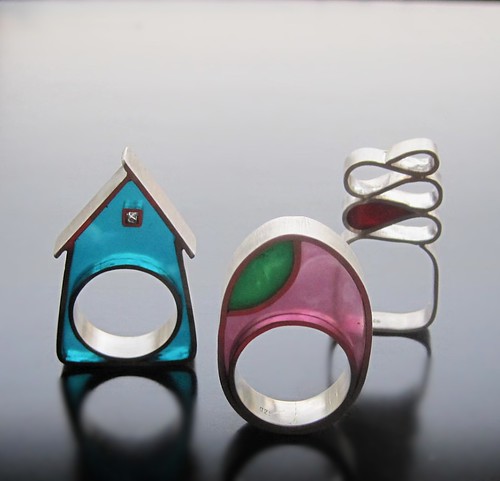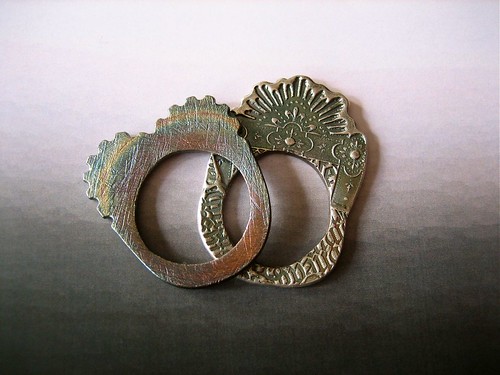For the last several years my process has been to go in and work with the metal. I had a hard time drawing in 2-d something I was making in 3-d. My 3-d pieces never seemed to look like my sketches. A drawing doesn't give you the feeling of bending or folding or torching something. But lately, I feel that those years were used to get the feeling into my fingertips of what the metal could do, to gather all the information. Now I feel like I want to put all that information together into a well thought out piece and a well thought out piece, for me, takes research, thinking, studying other work, drawing, thinking... I still may have to experiment to see what the metal can do, but I need to have a plan.
Here are a few Ring A Week examples of what I think use good, well-thought-out design elements:


Victoria Takahashi (experimetal)
http://www.flickr.com/photos/experimetal/5402761051/in/photostream/
 Shae and Aubrey
Shae and Aubreyhttp://www.flickr.com/photos/citizenobjects/with/5434224239/
 Maria Apostolou
Maria Apostolouhttp://www.flickr.com/photos/maria_apostolou/with/5424766653/
 Catherine Witherell
Catherine Witherellhttp://www.flickr.com/photos/happydayart/with/5364908813/
I got the following information out of what looks like a high school textbook called 'Exploring Metalwork, Fundamentals of Technology' (John R. Walker, The Goodheart-Willcox Company, Co. 1995, pp. 51-57) from the library. Oddly enough the whole book is pretty informative and interesting. The following is from Unit 4.... Designing a Project:
"Elements of Good Design:
- Lines. Lines are used to define and give shape to an object.
- Shape. The shape of an object may be determined by the way it will be used.
- Form. The 3-d shape of the object. It may be round, square, or some other geometric shape.
- Proportion. The balance between parts.
- Balance. An object has balance when its parts appear to be of equal weight. When the parts on each side of the centerline are alike in shape and size this is called SYMMETRICAL BALANCE. INFORMAL BALANCE presents a design in such a manner that the balance cannot be measured. However, there is a feeling that the design is balanced.
- Unity. A design with unity brings the various parts together as a whole. Each part of the object seems to have a relationship to another part.
- Emphasis. This is where the design is given a point of interest.
- Rhythm. Rhythm is achieved by the repetition of lines, curves, forms,colors, and textures within the design. It gives an object a pleasing appearance.
- Texture. Texture is the condition of the surface of a material. Texture can be added by cutting, pressing, perforating, rolling, or expanding.
- Color. All metals have a color of their own Colors may also be added using chemicals, paints, lacquers, or other finishing materials. Selection of color is important.
Solving a design problem
- State the problem
- Think through the problem
- Develop your ideas
- Prepare working drawings.
- Construct the project.
It takes time to acquire the skill to develop well-designed projects.YOU LEARN BY DOING. Keep a notebook of your ideas. Include photos of the projects you have designed and constructed. By reviewing your notebook it will be easy to see how your design skills improve."
Not bad for a textbook!


What a great post Evelyn! So informative. Thank you for writing this.
ReplyDeleteThere are so many factors to consider when designing an object. Sometimes the process is intuitive but I believe that most of the times special studying, thinking and planning is required. This is when the result is most successful.
But you also need to make in order to learn. I learned so many things as I was making my latest resin collection, that wouldn't have happened if I kept planning and thinking forever :-)
What a thought provoking post! I love your examples here, too. I agree that design needs the experience of working the metal behind it.
ReplyDeleteI agree in order to make a great object you must design however I think that much of Art comes from the soul and personal gifts of the artist, the talent can be so natural that it only needs to practice to accomplish the wonderful! You are turning into quite the art teacher EEEE, great article,,,you also are making such fluid like pieces I love them!!!
ReplyDeleteI guess there needs to be a balance between the two! I'm reading Stephen King's book 'On Writing' and a lot of what he talks about really translates to any medium. Maybe when I'm done, I'll report on it!
ReplyDeleteOh I love this post and not just because I'm in it. I like your list of elements and I agree that an artist needs some experience behind them so that when they are designing something they know what the pitfalls are and also the qualities of the medium they are using that will support the design, I do some drawing and I think about my plan for awhile but then I just have to jump in and see what's going to happen. I prefer that method because then I waste fewer of my resources on something that probably won't work. Near the end I might spend lots of time deciding on the smallest of elements that would enhance the finished design, like a mark or some bit of color somewhere. Then, I look at it some more and decide that to add any more would take it too far and I say the words "That's as good as it's going to get", like a ritual and I know that piece is finished. Often I start two the same way and end up with two that are very different like in this photo you used.
ReplyDeleteI have a notebook where I record the things I want to remember if I should need to make that object again. I study other artists' work to learn how they succeeded with their design and I know what I like, what is MY style.
I'm honored that you used my photo in your post. Thank you
Thanks Maria, Mary Lu, Dennise, and Catherine for your input on all this! It's this inter-activeness that makes the blogging so much richer. You all make good points. For me it is all the stuff that goes on in my brain that I am only a witness to. From the beginning of thinking of an idea and sketching it or working the metal to back to sketching and back to metal... and all the stuff in my brain that is saying I should be sketching/designing more while I'm working with the metal and then when I'm sketching/designing thinking that I should be more hands-on to thinking maybe this isn't working, I don't like it, maybe I should be working on something else to finally finishing it and then thinking... oh this is pretty cool... And then there is tonight... I've been working on my TADA piece, a variation on the folded forms I've been working on. I made a pretty cool piece, not finished, but it's 1:15am and I want to take a picture of it and post it. So I go into my office to get my camera card, decide to check my email, saw that Catherine commented, went to check it out... now I can't find the piece I want to photograph!!!! There's really not that many places where it can be... aughhhhh
ReplyDeleteHonored to be here as well Evelyn, thank you for including my ring! A lot of people cringe when I say this (mostly my professor friends), but by and large my work is all exploitive of 'the happy accident' or just simple play. I never sketch. I mean ever. I work extremely intuitively, directly in the metal. I can never view mistakes as merely mistakes. I feel that if I am making 'mistakes' it is my subconscious directly bypassing my rational brain. I know it sounds ephemeral and perhaps new-agey, but I am sticking to my guns! This does not however preclude learning from the mistakes I make. Often I find that the end result has strayed enormously from what I originally intended. I find that the less I fight this process, and the more I surrender to it, the closer I get to 'good' design.
ReplyDeleteOn a completely different note- Evelyn-stop looking for that piece, then you will find it!
I found it!!!! I had stuck a little pearl in it for the photo, not permanent, so I didn't want it to fall out so I stuck it on something a little higher than my work area!! Yay!! I would have never seen it (and didn't) last night, too tired too obsessed!!
ReplyDeleteYou know Shae it's really good to hear that! Whenever I work like that I feel like I'm doing something wrong. So not to run the fact that I am reading Stephen King's book 'On Writing' into the ground... but he says the same thing. No pre plot, no outline... he has an idea and writes and writes and writes and the story writes itself. It comes from all the stuff/knowledge we have buried inside ourselves and when we work long enough we let it out or are able to excavate it. The key idea is to work.
Ok, my next blog post will have to be about Stephen King!!